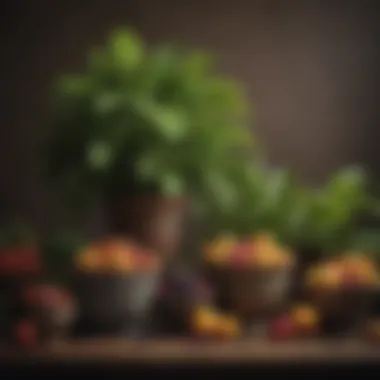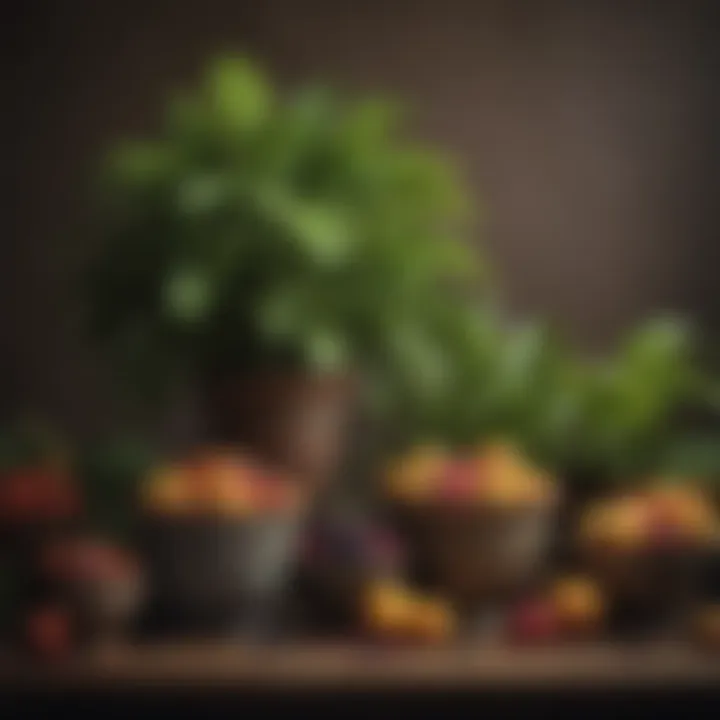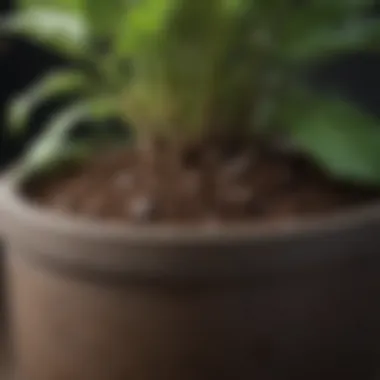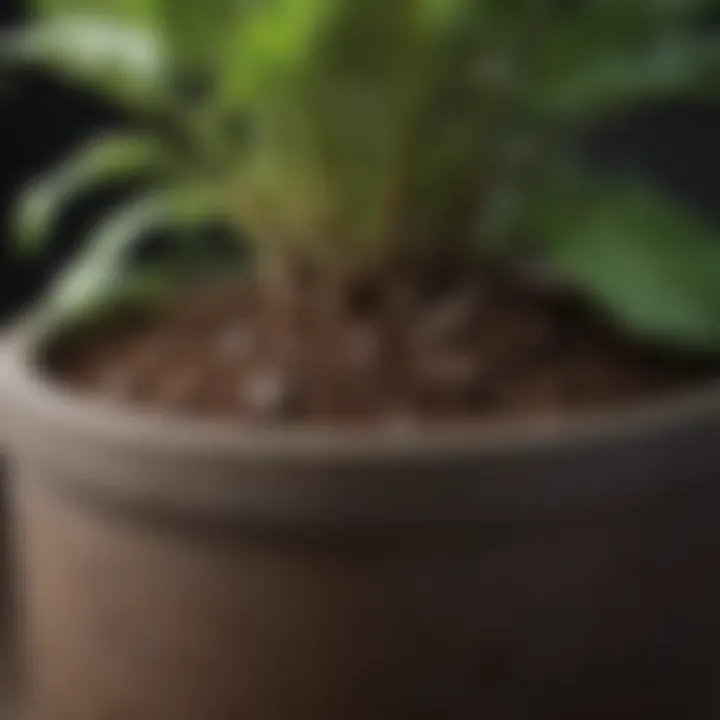Cultivating Fruit Plants in Pots: A Comprehensive Guide


Intro
Growing fruit plants in pots is a practice that increasingly appeals to urban dwellers and gardening enthusiasts alike. Container gardening offers flexibility, allowing individuals to cultivate a variety of fruit plants even in limited spaces. Whether you have a small balcony or a modest backyard, you can still enjoy the fruits of your labor. This guide aims to offer a thorough understanding of how to successfully cultivate fruit plants in pots, addressing essential factors such as plant selection, pot types, soil requirements, watering routines, fertilization methods, and pest control strategies.
Container gardening comes with its benefits. Not only does it help optimize space, but it also provides convenience and ease of maintenance. However, growing fruit plants in pots presents its unique challenges. Understanding these complexities entails more than just watering and fertilizing. A combination of practical advice and comprehensive insights will aid both novice and seasoned gardeners in achieving fruitful results in their endeavors.
Intro to Container Gardening
Container gardening has emerged as a significant method for growing plants, especially fruit varieties, in limited spaces. This practice allows individuals to cultivate various fruit plants without the necessity of expansive gardens or yards. Container gardening is particularly pertinent in urban areas where space is at a premium. This section will explore the definition and scope of container gardening and highlight the numerous benefits this method offers.
Definition and Scope
Container gardening involves the practice of growing plants in pots or containers instead of directly in the ground. This method can accommodate a wide variety of fruit plants, enabling gardeners to manage their cultivation effectively. It encompasses various gardening styles, including traditional, modern, and even vertical gardening.
The scope of this practice is broad, as it caters to different preferences and circumstances. From small balconies to patios, container gardening provides an excellent solution for individuals who wish to enjoy home-grown fruits without needing sprawling plots of land.
Benefits of Growing in Pots
Growing fruits in pots presents several advantages that make it an attractive gardening choice.
Space Efficiency
One of the key characteristics of space efficiency is the ability to optimize even the smallest areas. Container gardening allows individuals to utilize available space effectively. As a result, homeowners can grow fruit plants without the constraints of a traditional garden layout. This suitability makes it an ideal option for those in apartments or other limited spaces. Furthermore, choosing pots with varying sizes enables gardeners to maximize space, allowing for crop diversity in small areas.
Mobility and Accessibility
Mobility and accessibility are vital aspects of container gardening. By using pots, gardeners can rearrange their plants according to sunlight availability or aesthetic preference. This flexibility is beneficial, particularly for fruit plants that require optimal light conditions. Additionally, containers are easier to manage compared to in-ground plants, reducing the physical strain associated with bending down or reaching far into a garden. As a result, container gardening appeals to a wider audience, including those with physical limitations or older adults.
Enhanced Drainage
Enhanced drainage is another critical benefit of container gardening. Containers often allow excess water to escape, reducing the risk of overwatering, which can be detrimental to fruit plants. This characteristic is particularly advantageous in areas with heavy rainfall or when caretaking for specific types of fruits that require drier conditions. Furthermore, using specialized potting mixes can improve aeration and root health, leading to more vigorous plant growth.
Selecting the Right Fruit Plants for Pots
Selecting the right fruit plants for pots is a crucial step in container gardening. The choice determines not only the aesthetic appeal of your plants but also their health and productivity. Container gardening can be limited by space, so the plants must be well-suited for such conditions to ensure a thriving garden. Choosing the right species involves considering various elements, including growth patterns, climate compatibility, and expected yields. Understanding these considerations provides a solid foundation for successfully cultivating fruit in pots.
Best Fruit Plants for Container Growth
When it comes to growing fruit plants in containers, several varieties are particularly well-suited for this method. Below are some of the most popular choices:
Strawberries
Strawberries are among the best options for container gardening. Their compact growth allows them to fit well into smaller spaces, making them ideal for pots. Strawberries also produce fruit relatively quickly, giving gardeners a rewarding experience. One unique feature is their ability to produce offshoots or runners, which can be propagated for new plants. However, they do require consistent watering and soil that drains well.
Tomatoes
Tomatoes are another excellent fruit choice for pots. They are versatile and can thrive in various container sizes. The vigorous growth habit of tomato plants can yield a high quantity of fruit. Many varieties are suitable for smaller spaces, such as cherry tomatoes. These plants can be vulnerable to certain pests, but their productivity often outweighs the challenges. Proper staking or support is crucial to manage their growth.
Blueberries
Blueberries are appreciated for their flavor and health benefits. They also add visual interest with their flowers and vibrant foliage. One key characteristic is their need for acidic soil, which makes soil selection critical. Blueberries can thrive better in pots as this allows for better soil management. However, an essential consideration is their pollination needs, often requiring at least two different varieties to produce abundant fruit effectively.
Figs
Figs are a unique addition to container gardens. They are adaptable and can tolerate various conditions, making them an attractive option. Their growth habit is expansive, so choosing a larger pot can help accommodate their root system. One of the significant advantages is their ability to produce sweet fruit with minimal fuss. However, it's crucial to manage watering carefully as figs can suffer from overwatering.
Considerations for Plant Selection
When selecting fruit plants for your container garden, certain factors should be taken into account:
Growth Habit
Understanding the growth habit of the plants is essential. Some plants grow upright while others spread out. Choosing a plant that fits your spatial limitations can prevent future complications. Additionally, the growth habit can influence the plant's health and fruit production. For example, compact plants tend to do well in smaller containers where root space can become an issue.
Climate Suitability
Climate suitability plays a pivotal role in determining the success of container-grown fruit. It's vital to select plants that can thrive in your environment. Varieties that are suited for warmer climates may struggle in colder conditions and vice versa. Examine the hardiness zone of your area to make informed choices. This analysis also involves understanding local temperature fluctuations that could affect your plants’ growth.
Fruit Yield
Finally, the expected fruit yield is another essential consideration. It varies significantly between different types of fruit plants. High-yielding plants can offer greater rewards for your efforts. However, it's important to temper expectations. Not all fruit plants will yield equally in a container, so understanding the specifics of each variety can guide selections.


The key to successful container gardening lies in the careful choice of plants. These selections can define the overall experience as well as the productivity of your garden. Ensuring that chosen fruits align with both personal goals and cultivation capabilities is vital.
Container Choosing and Sizing
Selecting the right container for growing fruit plants is crucial to their success. The choice of pots, the material, and the size all play significant roles in plant health. The right container allows for adequate drainage, supports root development, and helps manage nutrients effectively. Consequently, it is essential to understand the different types of containers available and how to assess the appropriate size for your chosen fruit plants.
Types of Pots
Plastic vs. Clay
When deciding between plastic and clay pots, one must consider how each material affects the growing environment. Plastic pots are lightweight and often less expensive, making them a popular choice for many gardeners. They can retain moisture longer than clay due to their non-porous nature, which may reduce the frequency of watering. This characteristic is beneficial for those with busy lifestyles. However, plastic pots may lead to overheating during hot weather since they lack the breathability that clay offers.
On the other hand, clay pots are porous, allowing for better aeration of the soil. This feature promotes healthy root systems as it prevents the roots from becoming waterlogged. Clay also maintains a more stable temperature, which can be advantageous in variable climates. Yet, they are heavier and can be more costly than plastic options. Thus, your choice should depend on your specific gardening needs and conditions.
Self-Watering Pots
Self-watering pots have become increasingly popular for container gardening. These pots include a reservoir that allows plants to access water as needed. This feature makes them an advantageous choice for maintaining consistent moisture levels, especially for fruit plants that require regular watering. Additionally, self-watering pots can reduce the risk of over and under-watering, which contributes to overall plant health.
The unique design of self-watering pots ensures that plants can draw moisture from the reservoir through a wicking system. This capability can be particularly beneficial for busy individuals or those who travel frequently. However, it is essential to monitor the water levels in the reservoir to avoid prolong periods of drought.
Hanging Baskets
Hanging baskets can offer a distinctive approach for growing certain fruit plants like strawberries. They maximize vertical space, making them ideal for patio or deck areas with limited floor space. A key characteristic of hanging baskets is their ability to enhance sunlight exposure to all sides of the plants, promoting even growth.
While they provide aesthetic appeal and practical benefits, hanging baskets have their challenges. They may require more frequent watering because they can dry out quickly, especially if placed in direct sunlight. Moreover, weight is a factor to consider, especially if the basket is large and filled with soil and plants. Balancing these aspects will lead to a satisfying gardening experience.
Determining the Right Size
Finding the right size of the container is just as important as selecting the type. A well-chosen pot allows fruit plants to grow to their full potential while maintaining healthy root systems.
Plant Maturity
Understanding plant maturity is crucial in determining the appropriate pot size. Some fruit plants, like tomatoes, can grow quite large. Therefore, starting with a container that accommodates their future growth is wise. Using a small pot may stifle the plant's development and lead to complications like root rot due to root crowding. Choosing pots according to the plant's growth stage ensures that they have enough space to thrive.
Root Space Requirements
Every plant species has unique root space requirements. Roots need adequate room to expand, which ensures better nutrient uptake and air circulation. As a general rule, deeper pots are needed for fruit plants, particularly those with prominent root systems such as blueberries or figs. If the roots do not have sufficient space, it can lead to stunted growth or poor fruit yield.
In summary, selecting the right container and size is vital for a successful potted garden. By understanding the materials, the benefits of different pot types, and the specific needs of your fruit plants, you can cultivate a healthy and productive container garden.
Soil and Nutrient Requirements
Understanding the soil and nutrient needs of fruit plants is crucial for successful container gardening. The right soil provides a foundation for root development, water retention, and nutrient availability. Poor soil can lead to weak plants, ultimately affecting fruit yield. Thus, gardeners must focus on what soil types are suitable and how to maintain nutrient levels as plants grow.
Preferred Soil Types for Fruits
Potting Mix Characteristics
Potting mix plays a significant role in fruit cultivation in pots. It is typically lighter than garden soil, which promotes better drainage and aeration. A good potting mix often contains a blend of peat moss, vermiculite, and perlite. These components allow for sufficient aeration, moisture retention, and proper drainage, enabling roots to thrive.
One key characteristic is its ability to retain moisture while preventing over-saturation. This is vital for fruit plants, as both dryness and excess water can negatively impact growth. A quality potting mix can also provide a stable pH level, which is essential for nutrient absorption.
However, the unique feature of some potting mixes is the inclusion of slow-release fertilizers. These options enrich the mix with essential nutrients, reducing the need for frequent fertilization, making them a practical choice for many gardeners.
Organic Options
Organic soil options have gained popularity for their numerous benefits in container gardening. These soils often include composted materials, which enhance soil structure and boost nutrient levels naturally. The use of organic soil promotes a healthier environment for microbial activity, further assisting in nutrient breakdown and uptake.
A notable characteristic of organic soil is its sustainability. Many gardeners prefer it for producing chemical-free fruits, aligning with a more eco-friendly gardening approach. The unique feature of organic soil is its ability to improve soil fertility over time. It can enhance the biological activity, providing ongoing benefits for container fruit plants.
One consideration to keep in mind is the cost. Organic soil can be more expensive than conventional potting mixes. Yet, the advantages in plant health often outweigh this extra cost in the long run.
Fertilization Strategies
Different fertilization strategies can optimize plant growth and fruit production in pots. Knowing what type of fertilizers to use and how to apply them correctly makes a difference.
Types of Fertilizers
Using the right type of fertilizer is key. Fertilizers come in multiple forms, including granular, liquid, and organic options. Granular fertilizers are commonly used for their slow-release properties, providing a steady supply of nutrients over time. Liquid fertilizers, on the other hand, allow for faster absorption, which can be beneficial during the growing season when plants have high nutrient demands.
An important aspect of fertilizers is their nutrient composition. Many fertilizers are labeled with a set of three numbers indicating the N-P-K ratio, representing nitrogen, phosphorous, and potassium. This helps gardeners understand what nutrients they are providing to their plants. In container gardening, balanced fertilizers are often preferred as they support all phases of plant growth, from developing roots to fruit production.


Application Techniques
The manner in which fertilizers are applied significantly influences their effectiveness. One efficient technique is to combine granular fertilizers with the potting mix before planting. This allows for proper nutrient distribution throughout the growing medium.
For liquid fertilizers, dilution is important. Following the manufacturer's instructions ensures that plants receive the right concentration. A beneficial technique is to apply liquid fertilizers during routine watering. This promotes even distribution, enhancing nutrient uptake without risking root burn.
Watering Techniques
Watering techniques play a crucial role in the success of fruit plants grown in pots. Proper watering ensures that your plants receive adequate moisture to thrive while avoiding the dangers of overwatering or underwatering. Understanding the water needs of your plants is fundamental, as containers can dry out faster than garden beds due to limited soil volume and exposure to air. Let’s delve into the specifics of managing water effectively in container gardening.
Understanding Water Needs
Signs of Overwatering
Overwatering can lead to numerous problems for potted fruit plants. One significant aspect of overwatering is the reduced oxygen available to the roots. When soil becomes overly saturated, drainage is impeded, leading to root rot and stunted growth. Key characteristics to watch for include yellowing leaves, wilting, and a sour smell emanating from the soil. These signs suggest that the roots are suffering from a lack of oxygen.
Overwatering is often a common mistake, especially among novice gardeners. Knowing when to dial back on the water can keep your plants healthier. A unique feature of this issue is that it can be deceptively difficult to identify, as the symptoms mimic those of underwatering. Therefore, understanding the plants' moisture needs is vital in nurturing fruit plants grown in pots.
Signs of Underwatering
On the other end of the spectrum, underwatering presents its own challenges. Dry, shriveled leaves and soil that pulls away from the edges of the pot indicate that the plant is not receiving enough moisture. If left unattended, underwatering can result in leaf drop and eventual plant death. The critical characteristic of this problem is that symptoms often develop more slowly than overwatering.
Unlike overwatering, underwatering can be easier to correct. A unique advantage here is that with attentive care, most plants can bounce back quickly once watering resumes. This adaptability makes it important for plant owners to be aware of their plants’ specific requirements.
Efficient Watering Methods
Drip Irrigation
Drip irrigation systems are becoming increasingly popular among container gardeners. This method allows for consistent, slow application of water directly to the root zone of the plants. The primary benefit of drip irrigation is its efficiency; it minimizes water waste and helps maintain soil moisture levels without the danger of overwatering.
One unique feature of drip irrigation is that it can be automated, providing convenience for busy gardeners. However, there are disadvantages as well. Installation can be complex and may require investment in additional equipment, which might not be suitable for every homeowner.
Hand Watering Best Practices
Hand watering remains a timeless technique, favored for its ability to control moisture application precisely. This method allows gardeners to evaluate the soil's moisture levels manually, making it a beneficial choice for those who prefer a more hands-on approach.
A key characteristic of hand watering is flexibility. Gardeners can adjust their watering based on real-time observations of their plants’ needs. However, this method can be time-consuming and might lead to uneven watering if not performed carefully. Thus, developing a consistent routine and paying attention to your plants can help mitigate these disadvantages.
Effective watering techniques are fundamental for maintaining healthy fruit plants in pots. By understanding the needs of your plants and implementing suitable watering methods, you ensure their well-being and fruitful yield.
Managing Pests and Diseases
Managing pests and diseases is crucial for anyone wanting to grow fruit plants in pots. Container gardens can be vulnerable to various pests and diseases that may threaten the health of plants. Unlike traditional gardens, container plants can face specific risks due to their confined spaces. This section discusses these risks and provides guidelines on how to address them effectively.
Common Pests in Container Gardens
Pests often invade garden spaces and can cause significant damage to plants. Understanding the common pests helps gardeners take proactive measures. Here are three of the most common pests found in container gardens:
Aphids
Aphids are small, soft-bodied insects. Their presence can lead to stunted plant growth as they sap vital nutrients from the fruit plants. A key characteristic of aphids is their rapid reproduction rate. In warm conditions, they can multiply quickly, causing infestations.
Aphids are known for being a beneficial topic for this article because they often attract predators like ladybugs, which can also control their population. However, they can also secrete a sticky substance called honeydew that may lead to sooty mold. This is a disadvantage because it reduces photosynthesis effectiveness in affected plants.
Spider Mites
Spider mites are another problematic pest. They are not insects but rather related to spiders, making them unique in how they operate. Spider mites are particularly harmful when plants are in dry conditions. Their ability to weave webs can also interfere with plant growth, making them a significant pest in container setups.
The key characteristic of spider mites includes their small size and fast reproduction. They are notably popular in discussions about plant health as they can quickly deplete moisture from the leaves. This may weaken plants and make them susceptible to other stress factors. Their webs on plants are a visible sign of an infestation, which is both an advantage and disadvantage in identifying infestations easily.
Whiteflies
Whiteflies, tiny white insects, are also frequent visitors in container gardens. They will gather on the undersides of leaves and suck sap. This can lead to yellowing of leaves, affecting photosynthesis processes. A key characteristic of whiteflies is their ability to produce honeydew, attracting other pests and leading to mold.
They are considered a popular topic in pest management discussions due to their stubborn nature and rapid reproduction. An advantage of whiteflies is that their presence often signals other problems such as poor air circulation, allowing gardeners to address broader issues affecting their plants. However, if not dealt with, they can result in considerable damage to fruit plants, stressing their health.
Disease Prevention Techniques
Preventing diseases in container gardens involves routine monitoring and prompt action when issues arise. This can include selecting healthy plants and implementing proper care practices. Here are two specific areas that could be problematic:
Fungal Issues
Fungal diseases can be a major threat to container fruit plants. These issues often arise from damp and humid conditions. A key characteristic of fungal problems includes the appearance of mold or mildew on the surfaces of soil or leaves. This can lead to plant decline, making it a critical aspect to manage in container gardening. Preventive measures include ensuring proper air circulation and avoiding overwatering, as these practices can effectively reduce fungal infestation chances. An advantage of addressing fungal issues early is that it can save the entire plant from significant damage.
Bacterial Problems
Bacterial diseases can also impact fruit plants severely. These diseases may be less visible initially compared to fungal issues but can spread rapidly through water. A key characteristic of bacterial problems involves wilting or discoloration of leaves, which can indicate underlying infections. Understanding bacterial problems is a beneficial aspect to include in this article, as preventing them requires different tactics than fungal management. The unique challenge of bacterial issues includes their often invisible nature until advanced stages, making fast identification critical. Early action can help prevent widespread issues that may require more drastic solutions.


It is essential to maintain vigilance in both pest and disease management to ensure healthy growth of fruit plants in pots. Regular inspections and timely interventions can minimize risks and promote vibrant growth.
Seasonal Care Tips
Seasonal care is crucial in container gardening, especially when it comes to fruit plants. Changes in weather and temperature can significantly affect the health of your plants. Understanding the specific needs of your plants during different seasons helps optimize growth and maximize yield.
Spring Planting Strategies
In spring, the focus is primarily on planting and establishing your fruit plants. It is essential to wait until the last frost date has passed before you start planting. During this time, you can choose to sow seeds or plant young seedlings. Additionally, consider the following strategies:
- Soil Preparation: Start with a quality potting mix. You can enhance this with organic matter, such as compost, to increase nutrient availability.
- Choosing Right Varieties: Select fruit plants that grow well in your climate. Strawberries and tomatoes are popular choices during this season.
- Acclimatization: If your plants were indoors or in a greenhouse, gradually expose them to outdoor conditions for a few days to avoid shock.
Summer Maintenance Practices
As temperatures rise, so do the challenges associated with maintaining container gardens. During summer, plants generally require more attention. Key maintenance practices include:
- Regular Watering: Ensure your fruit plants receive consistent moisture. Containers can dry out quickly in the heat, so check soil moisture levels often.
- Fertilization: Apply a balanced fertilizer every few weeks. This ensures that your plants have sufficient nutrients to support their growth.
- Pruning and Training: Depending on the type of fruit plant, regular pruning may be required to promote healthy growth and fruit production. Tie vines or branches to support structures if necessary.
Preparing for Fall and Winter
As summer transitions into fall, it is time to prepare your plants for the colder months. This is essential for the survival of your potted plants through winter.
- Harvesting: Ensure you harvest ripe fruits from your plants to avoid rot and pest problems.
- Inspection: Check for pests and diseases. Treat any issues before they worsen, as they can spread more rapidly in cooler temperatures.
- Sheltering Plants: When temperatures drop, move pots to a protected location. This may be a garage or covered porch, particularly for tender varieties.
Preparing your fruit plants for seasonal changes is vital to ensure their longevity and productivity. Monitor their needs closely as conditions change.
Maintaining awareness of these seasonal considerations not only encourages successful growth but also fosters a deeper connection to your gardening practices. Whether you are producing strawberries in spring or ensuring your plants survive the chill of winter, each season brings opportunities for learning and adjustment.
Common Challenges in Container Gardening
Growing fruit plants in pots offers numerous advantages, but it also presents distinct challenges that gardeners must address. Understanding these bottlenecks can significantly enhance one's ability to cultivate robust and fruitful plants. The difficulties involve nutrient management, environmental conditions, and the broader considerations that come with container gardening.
Limited Nutrient Availability
One of the primary challenges faced in container gardening is nutrient availability. In a traditional garden setting, plants can access a wide range of nutrients from the soil surrounding their roots. In pots, however, the available soil volume is restricted, and nutrients can become exhausted rather quickly. This limitation necessitates careful monitoring of soil nutrients and more frequent fertilization.
To maintain proper nutrient levels, consider using high-quality potting mix enriched with organic matter. Regularly applying fertilizers can help replenish essential nutrients that are depleted over time. Remember to select fertilizers that are suitable for fruit plants, as they have specific needs depending on their growth stage.
Environmental Factors
Environmental factors play a significant role in the success of container gardening, particularly concerning temperature fluctuations and sunlight exposure. Both elements affect plant growth and fruit production, requiring attention to specific needs in these areas.
Temperature Fluctuations
Temperature fluctuations can create stress for fruit plants in containers. Unlike gardens in the ground, potted plants have their roots heavily exposed to changing temperatures, which can lead to inconsistent growth patterns. Maintaining a stable environment is crucial.
For example, placing pots in sheltered locations can mitigate extreme temperature swings. Additionally, using insulating materials can help regulate the temperature of the pot's contents. The key characteristic of temperature control is its impact on overall plant health, allowing for steady growth and improved yield during their growing season.
Sunlight Exposure
Sunlight exposure is another critical factor affecting container fruit plants. Different plants have various light requirements, and understanding these needs is essential for maximizing fruit yield. Most fruit plants prefer at least six hours of direct sunlight daily.
However, too much sunlight can lead to overheating and dehydration. A balance must be achieved to ensure the plant thrives. Therefore, it is wise to monitor sunlight patterns and potentially relocate pots to optimize their exposure. Knowing how to manage sunlight can be advantageous in achieving sustainable plant growth.
Proper management of environmental conditions will lead to healthier plants and more fruitful harvests.
In summary, while container gardening offers many rewards, being mindful of limited nutrient availability and environmental factors is essential. By addressing these challenges proactively, growers can foster thriving fruit plants, regardless of the constraints that pots present.
The End and Future Considerations
Cultivating fruit plants in pots offers a unique approach to gardening. This method allows individuals to grow a variety of fruits, even in limited spaces. As urban living spaces diminish and environmental concerns gain prominence, container gardening emerges as a pragmatic solution. Hence, understanding its potential and the considerations needed for successful growth is essential for both novice and experienced gardeners.
Key elements to note include the importance of choosing appropriate plants, containers, and soil mixtures. The type of fertilizer and watering methods also play a crucial role in fruit production. As discussed earlier, managing pests and diseases is vital to ensure healthy growth.
Gardeners should be aware of seasonal shifts, as these can greatly impact the care and maintenance of their container plants. Providing suitable conditions for growth, including adequate sunlight exposure and temperature regulation is beneficial for fruit yield.
Container gardening allows for the integration of nature into urban environment, promoting sustainability and personal well-being.
Key Takeaways
- Container gardening enables the cultivation of fruit plants in limited spaces, making it an ideal choice for city dwellers.
- Understanding the specific needs of different fruit plants enhances the potential for successful growth.
- Proper care and maintenance practices contribute to higher yields and healthier plants.
Emphasizing Sustainability
Sustainability in container gardening is increasingly critical. Growing fruit plants in pots supports local ecosystems and reduces the carbon footprint associated with transporting produce. By practicing sustainable gardening techniques, individuals can participate in a responsible approach to food production.
This involves selecting organic fertilizers and pesticides whenever possible, reducing chemical usage. Moreover, reusing containers and utilizing compost improve soil health while minimizing waste. Engaging in productive yet sustainable gardening practices not only benefits the environment but also contributes to individual health by providing fresh, home-grown produce.















